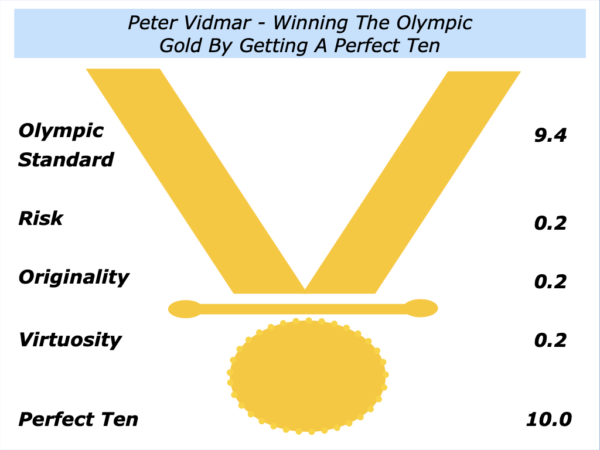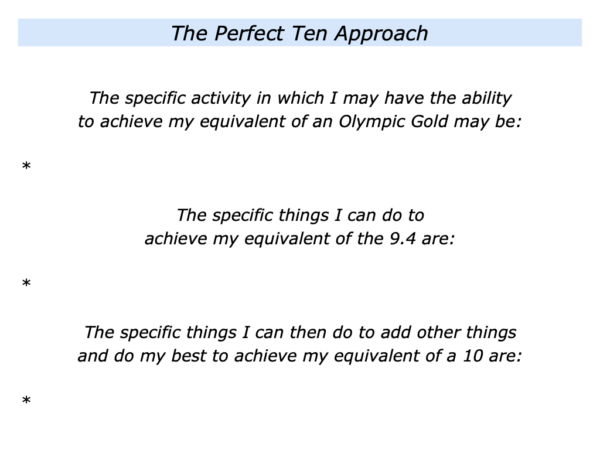
There are many ways to do fine work. One approach is to have a gold medal mentality. Let’s explore one model on this theme.
Peter Vidmar won a Gold Medal in gymnastics at the 1984 Los Angeles Olympics. Looking back at how his event was scored in those days, he describes the steps people took to get a Perfect Ten, which was first achieved by Nadia Comaneci in Montreal.
They must first achieve the Olympic standard of competence. This often took years of dedication and would give them the 9.4.
They could then add 0.2 by taking a risk; 0.2 by demonstrating originality – something that had never been done before; and 0.2 by showing virtuosity – flair. Such a brilliant performance would produce a 10 and, hopefully, the Olympic Gold.
Peter is an inspiring speaker. Many people leave his sessions fired up. Some say:
“We can now believe in our dreams. All we have to do is to be original, take risks and demonstrate virtuosity.”
They only forget one thing. Peter’s most important message is that people must first achieve the 9.4. That is the first step towards winning an Olympic Gold.
Imagine you want to follow elements of this approach. Here are three steps you may want to take in your own way.
You can choose an activity in which
you stand a chance of achieving a 10
One approach is to focus on an activity where you stand of a chance of delivering peak performance. What is your professional version of the Olympics? Which is the event – the activity – in which you stand a chance of competing for a gold medal?
On the other hand, you may not be interested in competition. You may be a pioneer who invents a new event. Great performers are, by definition, extremists. They are extremely good at what they do. In the business world, for example, they are often brilliant niche suppliers.
Focus on the activity where you are in your element – at ease and yet also able to excel. There is no point in going into an event where, at best, you can only get a 6.
You can work to achieve the 9.4
Great workers build on their strengths and also prepared to sweat. They pursue their chosen strategy, find solutions to challenges and work hard to achieve success.
How can you pursue this path in your own way? As ever, you can start by clarifying what you can control in the situation.
You can then aim: a) to clarify the picture of success; b) to clarify the key strategies you can follow to give yourself the greatest chance of success.
Clarify your road map, complete with milestones, and set out on the road towards achieving your goals. You can then develop your daily disciplines.
Start each day with an early success, perform superb work and encourage yourself on the journey. Keep doing the right things in the right way until they become second nature. Do everything possible to reach your equivalent of the 9.4.
You can add the risk, originality
and virtuosity to achieve the 10
Great workers deliver the goods at vital moments. Providing the foundation is in place, they may take what appears to be a risk. But in their minds – or in their muscle memory – they have done it a thousand times. One person expressed this in the following way.
“People say that I take risks, but I have already rehearsed all the scenarios, explored the possible strategies and settled on the way forward.
“I feel comfortable with what I am doing. In fact, it would be a greater risk not to take what appears to be a risk.”
Great performers also do something that appears original. But it is the result of spending hours, days or months finding creative solutions to challenges. Then comes the final piece: virtuosity, flair or showmanship.
They may do something magical that stays in people’s minds forever. How can you follow these steps in your own way? How can you build on the 9.4 and do your best to produce your equivalent of a 10?
If you wish, try tackling the exercise on this theme. This invites you to complete the following sentences.







Leave a Reply